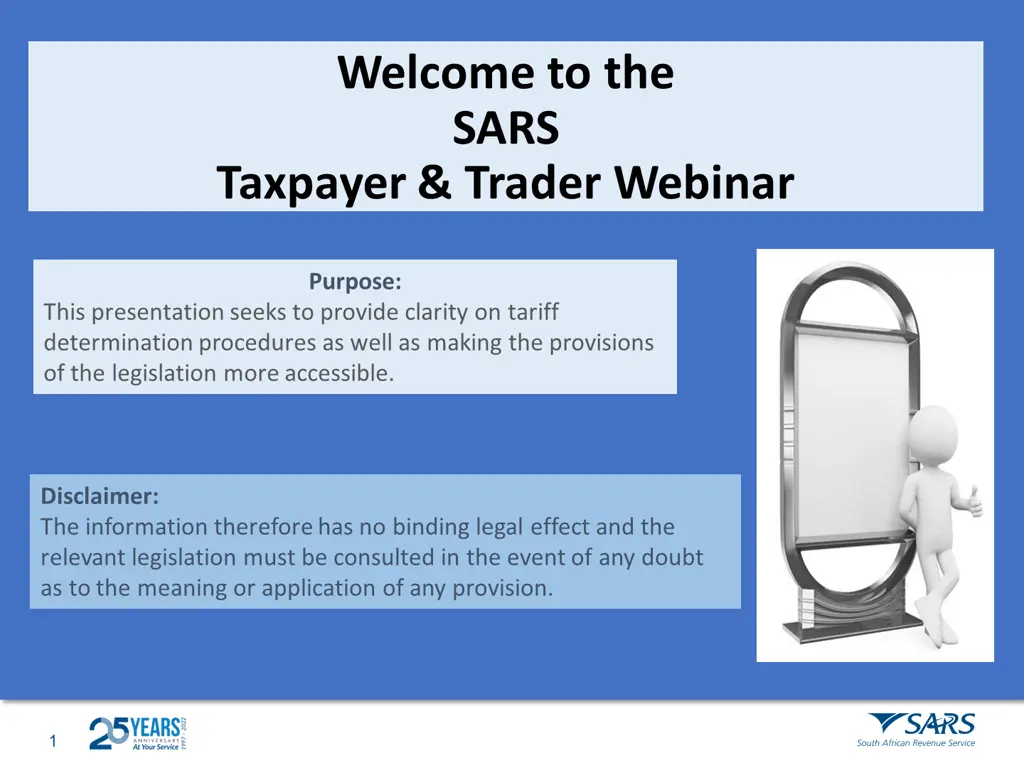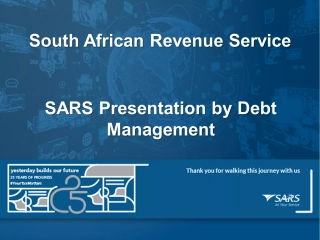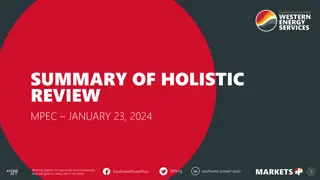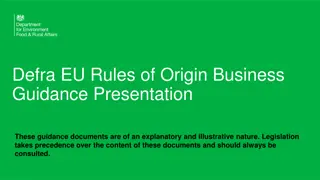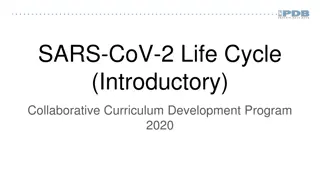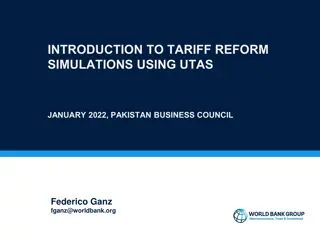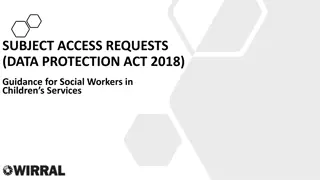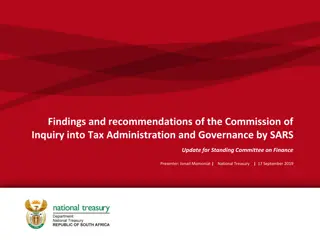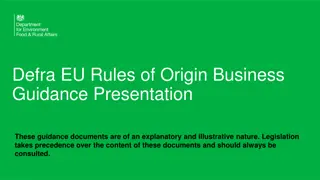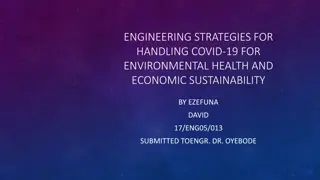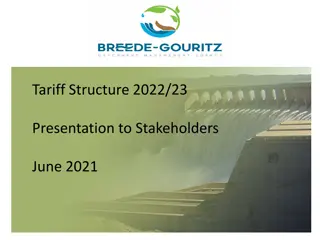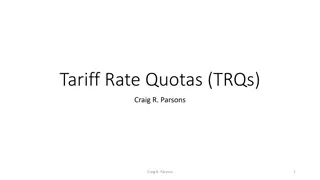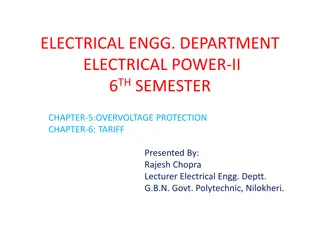Understanding SARS Tariff Determination Process
Explore SARS procedures for tariff determination and legislation provisions. Discover key discussions on customs, compliance, and international conventions.
Download Presentation

Please find below an Image/Link to download the presentation.
The content on the website is provided AS IS for your information and personal use only. It may not be sold, licensed, or shared on other websites without obtaining consent from the author. Download presentation by click this link. If you encounter any issues during the download, it is possible that the publisher has removed the file from their server.
E N D
Presentation Transcript
South African Revenue Service Tariff Determination Process
Welcome to the SARS Taxpayer & Trader Webinar Purpose: This presentation seeks to provide clarity on tariff determination procedures as well as making the provisions of the legislation more accessible. Disclaimer: The information therefore has no binding legal effect and the relevant legislation must be consulted in the event of any doubt as to the meaning or application of any provision. 1
SARS Vision 2024 To build a smart modern SARS with unquestionable integrity, trusted and admired by Government, the public, as well as our international peers. For the purpose of this presentation, we focus on 5 of our 9 Strategic Objectives: MODERNIZE SYSTEMS TO PROVIDE SEAMLESS ONLINE DIGITAL SERVICES MAKE IT EASY & SIMPLE TO COMPLY MAKE IT HARD TO NOT COMPLY USE DATA FOR INSIGHTS, RISKS & IMPROVED OUTCOMES CREATE AWARENESS, CLARITY & CERTAINTY 2
Points of Discussion Legislation Revised Kyoto Convention Harmonised System Non-Compliance Tariff Determination Process Stage Consignment Disputes 3
Revised Kyoto Convention The Revised Kyoto Convention commits contracting parties to the following principles: Is an update and revision of the International Convention on the Simplification and Harmonisation of Customs procedures and practices Transparency and predictability of Customs actions Simplified procedures for authorized persons Partnership with the trade Coordinated interventions with other border agencies, etc 6
International Law on Penalties Customs offences are provided for in Annex H national legislation to provide for customs offences. Chapter 9 Standard 9.8 - decisions to be in writing in line with national legislation. Chapter 10 the right of appeal, form, grounds, and consideration of the appeal. 7
What is Tariff Classification? Is the process whereby any imported, manufactured, and or exported commodity is categorised by virtue of: What it is How it is made What it is used for Classification of imported or exported goods must be done according to Section 47(9) of the Customs and Excise Act ( the Act); the General Rules of Interpretation and the other principles of the Harmonised System (HS) 8
Why do we need to Classify Goods? To establish the applicable rates of duty To establish which additional duties are payable for the imported commodities International trade statistics purposes Trade Agreements Prohibited and Restricted goods Rebates 9
Stages of Tariff Classification Classification of goods is a 3 stage process: Thirdly, select the heading which is most appropriate to the goods, taking the relevant headings, as well as the section and chapter notes into consideration. There are explanatory notes to clarify the above in conformity with the above Secondly, considers the nature and characteristics of the goods Firstly, ascertain the meaning of the words used in the headings and relative section as well as the chapter notes, which may be relevant to the classification of the goods concerned. 10
Harmonised System Adequate communications systems e.g., HS Committees It includes availability of sufficient national tariffs i.e. product list or Nomenclature Harmonised System is a multi-purpose legal tool It is a source of many trade policies etc. international agreements and regulations Clear instructions through circulars (up-to-date amendments) Proper classification principles 12
Tariff Book Example 13
GRIs Harmonised System HS has six General rules for the interpretation (GRI 1 to 6) They are the main tool for the daily application of the HS GRI 1 stipulates that classification is determined according to the terms of the headings and of any relevant Section or Chapter notes Apply GRI 2 to 5 in consequential order if classification cannot be so determined According to GRI 6 Rules 1 to 5 govern classification at subheading levels within the same headings and only subheadings at the same level are comparable 14
GIRs Harmonised System Rule 1: The titles of sections, chapters, and sub-chapters are provided for ease of reference only. Terms of the headings and any relative section or chapter notes Examples: Section XV - Base metals and articles of base metal However, many articles of base metal are classified elsewhere, e.g. Revolvers: Section XIX Machinery: Section XVI Chapter 44 Wood and articles of wood However, wooden furniture is classified in chapter 94 15
GIRs Harmonised System Rule2a: Incomplete or unfinished articles provided having the essential character of the complete or finished article Incomplete bicycles that have the essential characteristics of complete bicycles if it consists of the frame, the fork, and at least two of the following components: a set of wheels a crank-gear a steering unit (including handlebar and handlebar stems) a brake system 16
GIRs Harmonised System Rule 2b: Mixtures or composite articles -- > GIR 3 Examples: a consignment of dried peas (51%) and sugar (49%) 17
GIRs Harmonised System Rule 3: Classification of goods classifiable under two or more headings Three methods of classification in the following order of priority: Rule 3(c) - heading which occurs last Rule 3(a) most specific description Rule 3(b) - essential character in numerical order 18
GIRs Harmonised System Goods newly appeared on the world market, not specifically covered by any heading of the HS shall be classified in the heading appropriate to the goods to which they are most akin Cannot classify in terms of GRI 1 to 3 and then compare the goods with similar goods. Rule 4: Most akin A handle made of moulded plastic roll with a self-adhesive paper (so-called textile roller ). Not classifiable under a specific heading, most akin to brushes of heading 9603 White tea 19
GIRs Harmonised System Rule 5a: Containers: Camera cases, musical instrument cases, gun cases, etc, shall be classified with such articles when of a kind normally sold therewith. Example: Set put up for retail sale consisting of: pair of plastic roller skates, adjustable in length durable plastic wheels, knee, and elbow protectors protective plastic helmet special designed plastic transparent rucksack 20
GIRs Harmonised System Rule 5b: Subject to the provisions of Rule 5 (a) above, packing materials and packing containers presented with the goods therein shall be classified with the goods if they are of a kind normally used for packing such goods. Example 1) MP3-sunglasses Top brand sunglasses with incorporated MP3 player with headset and Bluetooth 21
GIRs Harmonised System RULE 6 For legal purposes, the classification of goods in the subheadings of a heading shall be determined according to the terms of those subheadings and any related Subheading Notes and, mutatis mutandis, to the above Rules, on the understanding that only subheadings at the same level are comparable. 22
Example of Subheading 09.01 Coffee, whether or not roasted or decaffeinated; coffee husks and skins; coffee substitutes containing coffee in any proportion: 0901.1 - Coffee, not roasted: 0901.11 - - Not decaffeinated: 0901.11.10 9 - - - Of the species Coffea arabica kg free 0901.11.20 6 - - - Of the species Coffea robusta kg free 0901.11.90 7 - - - Other kg free 23
Other Classification Principles Sections 21 Sections Chapters - there are 99 Chapters, Chapter 77 reserved for future use and Chapters 98 and 99 reserved for national use Tariff headings 4-digit tariff headings Tariff subheadings 6-digit and 8 digit tariff codes Legal Notes Chapter and Section Notes. General Rules of Interpretation GRI 1 to GRI 6 25
Other Classification Principles Continuing Arrangement of Sections and chapters is based on: Material content It is based on usages Stage of processing Legal Notes Sections, Chapters, and subheading notes provide the legal basis for the classification of goods. 26
Penalties Monetary penalties Offences may render the recipient or importer liable to, as provided for in the Act: Failure to adhere to the provisions of the Act is considered an offence Criminal prosecution Suspension or cancellation of registration, license, or accreditation 28
Tariff Application Process Any person intending to import or export must register with SARS in terms of the Act Registration can be done: via eFiling or Customs Branch Office In the event that clients are unable to classify goods, they must apply for tariff determination A tariff determination process can arise either from the client or as a departmental submission 30
Tariff Determination Process Customs Declaration External & Internal Stakeholders Role players Customs Inspections Customs & Excise Audit 31
Determining Tariff Heading A declaration released as entered or an opinion given verbally is not deemed to be a tariff determination Goods are classified as presented during the declaration process Once a tariff determination is issued, the Commissioner may amend or withdraw it to make a new determination for reasons stipulated in the Act Any determination that has been made is deemed to be correct subject to an internal dispute resolution or litigation process 32
Tariff Determination Process Customs Officer checks the tariff determination application Client submits tariff determination application to Customs Office Customs Officer captures the application details on the TDN system (DA314) Information Sufficient? Yes Officer sends the application manually to HO Customs Officer rejects the application No HO assesses the application for a determination Branch provides outcomes to the trader HO issues a determination & sends it back to the branch Tariff Determination External Policy: http://intranet/ProdQMS/Ops/CD/SC-CR-A- 09%20-%20Tariff%20Classification%20-%20External%20Policy.pdf 33
Tariff Determination for Alcoholic Beverages In terms of the Act, first-time importers, exporters, or manufacturers of alcoholic beverages require a tariff determination An application must be submitted at any regional office or Head Office for consideration The application must be accompanied by a signed certificate from the Department of Agriculture, Forestry, and Fisheries (DAFF) confirming that, the alcoholic beverage complies with the Liquor Products Act 34
Tariff Determination for Alcoholic Beverages Information to be enclosed in the submission is: the brand name process of the manufacturer, the ingredients used, and the proportion in which they are used the alcoholic strength; and any other information as may be required by the Commissioner 35
Staged Consignments An importation of unassembled or dissembled machinery for industrial purposes in different consignments but classified as one machinery/product What is it? 37
Staged Consignments In instances where the mass exceeds 500 tons or if the measurements for shipping purposes exceed 500 cubic metres, the Commissioner may allow the importation in staged consignment as provided for in terms of Additional Note 1 to Section XVI of part 1 of Schedule No 1 to the Act NB: The application must reach SARS prior to the importation of the first consignment and must comply with the requirements as set out in the Staged Consignment External Policy ( SC- CR-48) Goods in transit or bond through South Africa and goods exported from South Africa may not be classified as staged consignments 38
Internal Administrative appeal (IAA) Process If aggrieved by the decision of the Commissioner, the recourse is: To appeal within 30 days from the date of the tariff determination Alternative Dispute Resolution (ADR) within 30 days from the date of appeal outcome, or Litigation within 1 year from the date of appeal, ADR, or tariff decision The submission must be made at the office where the decision was issued. No duties, levies, or taxes, which are due and payable, may be waived; however, these amounts may be suspended pending the outcome of the applicable appeal committee s decision. 40
Litigation The notice must be given within a year from the date of receipt of the ADR outcome or to the address stipulated in the ADR notice. Applicants exercising these rights are required to give the Commissioner a notice in writing prior to instituting legal proceedings. Section 96 (1) (a) of the Act makes provision for appellants to litigate once all the internal dispute processes have been explored. 41
Finalisation of Tariff Determination Processes SARS will endeavour to finalise applications within timelines as stipulated in the Service Charter provided all required information is submitted Tariff determination within 90 days Appeal within 60 business days ADR within 90 business days Notice to litigate to be finalised within 30 days from date of receipt of such notice, subject to extension agreed between the parties http://intranet/sites/InFocus/Documents/InFocus%20and%20Newsflash%20documents /Service-Charter_2022-Final.pdf 43
Other Search Engines for Tariff Determination Census Bureau Schedule B Search Engine (3ceonline.com) Eurostat (3ceonline.com) https://ec.europa.eu/taxation_customs/dds2/ebti/ebti_consultation.jsp?Lang=en http://harmonizedsystem.wcoomdpublications.org http://www.itac.org.za/upload/43361_28-5_TradeIndustry.pdf https://sars.mylexisnexis.co.za/ https://www.sars.gov.za/legal-counsel/primary-legislation/schedules-to-the-customs-and- excise-act-1964/ Schedules to the Customs and Excise Act, 1964 | South African Revenue Service (sars.gov.za) http://intranet/ProdQMS/Ops/CD/SC-CF-48%20-%20Staged%20Consignment%20- %20External%20Policy.pdf 44
Go Digital Remember our Digital Channels We ve made it easier for you Go Digital! Register for eFiling Contact us: tdnquery@sars.gov.za Visit us on our Social Media platforms LinkedIn Facebook Twitter For more information on Tariff Determination, please visit: SARS website: www.sars.gov.za 45
